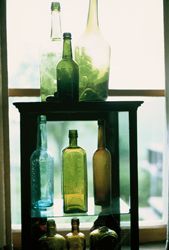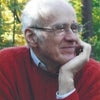
THE RANCHER’S BOTTLES
The ranch in the hills between Stanford and the Pacific was not only a refuge for us but also a teacher .Less than a half hour from the university, it belonged to a different world, a world of rumpled hills looking down to the ocean, land fit for raising cattle and, down lower, growing artichokes. One farm had a contract to supply perfect artichokes to a world-class restaurant in San Francisco. If a snail had nibbled on a single leaf, the choke went into a burlap bag to be given, free, to a neighbor. I would pick up the big sacks and keep my friends supplied.
It was the first time I had lived in the country. We inherited three dogs who slept in a heated porch and could go out at will. They would run down with me through redwoods to the pump that filled a wooden tank on the hill and, from it, an old bathtub where a herd of Black Angus would come to guzzle.
When the cows gave birth,the rancher would turn many of the young males into steers. “How do you do that?” I asked. “We just casterate them,” replied the rancher, pronouncing the extra “e.”
Life on the ranch was a continuing education for a kid raised in the suburbs. I learne to prune the orchard. I learned that deer may be friends to Walt Disney but not to a vegetable garden. I learned that a gopher can pull into his hole the entire limb of a tomato plant.
Our neighbor down the road created a pond by dozing an earthen dam, which lasted until the second winter brought an enormous rain and swept the dam away. Summers were better, except for the rattle-snakes. I was given a shotgun and told to dispatch any snakes that became “ornery.”
Our cabin, heated with a wood stove, was at the meeting place of rolling grassland, chaparral, and redwood forest. Friends who came up for picnics were reluctant to leave until sunset over the ocean.
What I liked most about the place was when the fog would tongue in from the Pacific, as visually thick as water, rising up sometimes almost to the level of where we lived. Rising out of the low wiry plants of the chaparral I built a tea platform on which to sit while the fog came in. almost high enough to carry me away if the platform had been a boat.
The ran ch was not only peacefulness. Guys with guns would occasionally com e up with their girl-friends and plug away at cans. How to induce them to move along before they killed a cow hidden by a bush? I would congratulate them on their aim and mention that an even better place lay just down the road.
Apart from the neighbor with the dam, the hills were alive with interesting people, including something vcalled the S.M.I.P. ranch. I discovered that tbe letters stood for “Syntex made it possible” and the owner was Carl Djerassi, a chemist then at Stanford, earlier at the firm that synthesized the main ingredient for birth control pills.
The rancher, who lived at the other end of a thousand acres, had a rare hereditary illness that would cause him to lose his sight. Meanwhile, he kept the place in good repair and had hobbies such as digging up old bottle left by prospectors. I don’t know what happened to him when he could no longer repair roads after the rains, maintain fences, create firebreaks when it got dry.
Probably his attitude was the biggest gift to me from those years on the ranch. Knowing that he had a slowly progressing disease, he cheerfully did what he could, which, when I knew him, was almost everything.
